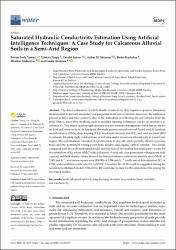Saturated Hydraulic Conductivity Estimation Using Artificial Intelligence Techniques: A Case Study for Calcareous Alluvial Soils in a Semi-Arid Region

Göster/
Tarih
2022Yazar
Yamaç, Sevim SedaNegiş, Hamza
Şeker, Cevdet
Memon, Azhar M.
Kurtuluş, Bedri
Todorovic, Mladen
Alomair, Gadir
Üst veri
Tüm öğe kaydını gösterKünye
Yamaç, S.S.; Negi ̧s, H.; Seker, C.; Memon, A.M.; Kurtulu ̧s, B.; Todorovic, M.; Alomair, G. Saturated Hydraulic Conductivity Estimation Using Artificial Intelligence Techniques: A Case Study for Calcareous Alluvial Soils in a Semi-Arid Region. Water 2022, 14, 3875. https://doi.org/10.3390/ w1423387Özet
The direct estimation of soil hydraulic conductivity (Ks) requires expensive laboratory measurement to present adequately soil properties in an area of interest. Moreover, the estimation process is labor and time-intensive due to the difficulties of collecting the soil samples from the field. Hence, innovative methods, such as machine learning techniques, can be an alternative to estimate Ks. This might facilitate agricultural water and nutrient management which has an impact on food and water security. In this spirit, the study presents neural-network-based models (artificial neural network (ANN), deep learning (DL)), tree-based (decision tree (DT), and random forest (RF)) to estimate Ks using eight combinations of soil data under calcareous alluvial soils in a semi-arid region. The combinations consisted of soil data such as clay, silt, sand, porosity, effective porosity, field capacity, permanent wilting point, bulk density, and organic carbon contents. The results compared with the well-established model showed that all the models had satisfactory results for the estimation of Ks, where ANN7 with soil inputs of sand, silt, clay, permanent wilting point, field capacity, and bulk density values showed the best performance with mean absolute error (MAE) of 2.401 mm h−1, root means square error (RMSE) of 3.096 mm h−1, coefficient of determination (R2) of 0.940, and correlation coefficient (CC) of 0.970. Therefore, the ANN could be suggested among the neural-network-based models. Otherwise, RF could also be used for the estimation of Ks among the tree-based models.

















